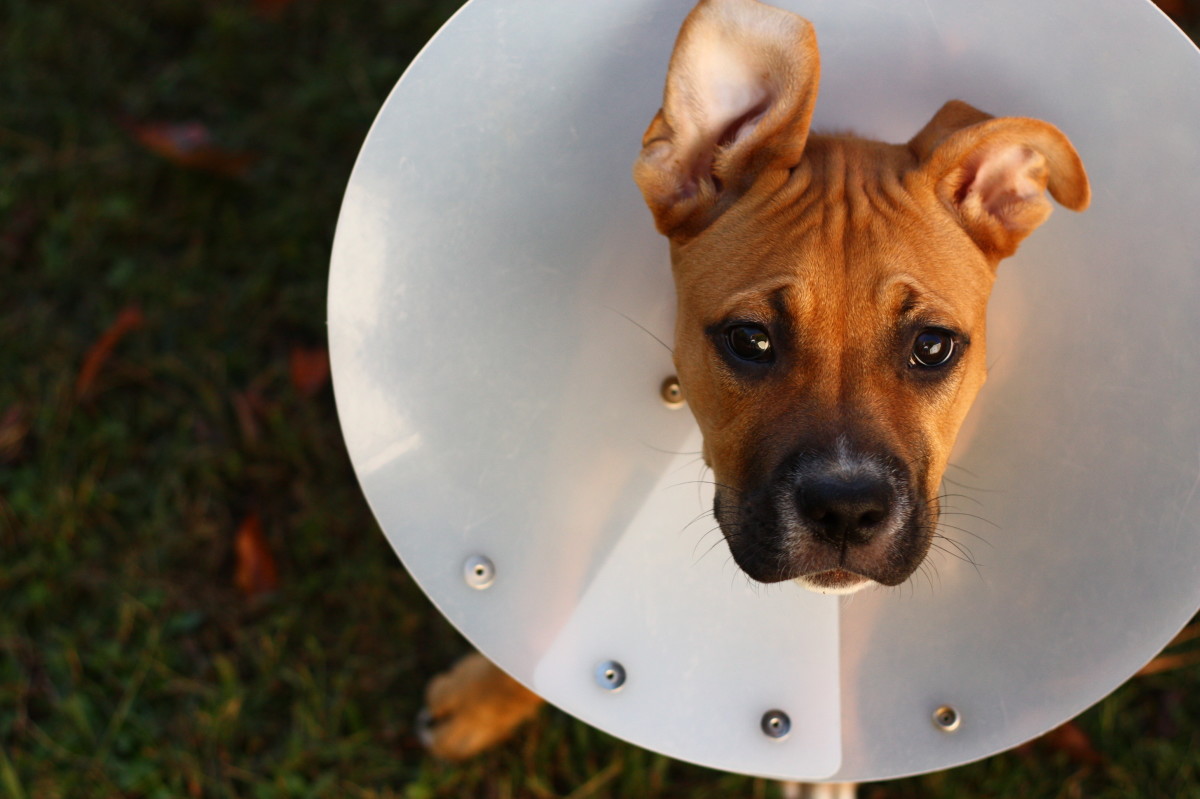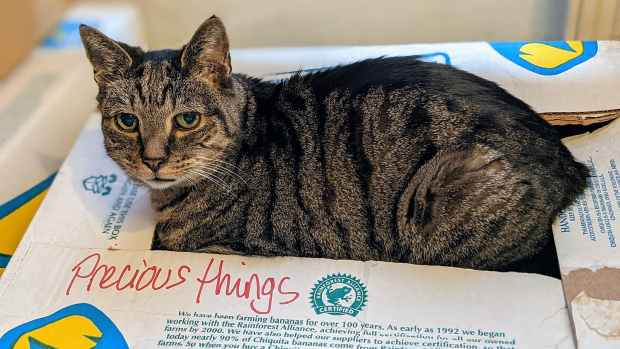Adrienne is a certified dog trainer and former veterinarian assistant who
partners with some of the best veterinarians worldwide.

Experts recommend spaying your dog, but making this decision might feel
overwhelming. Here you can learn about the FAQs so you can make an informed
decision.
Aidras CC BY-ND 2.0
Why Should I Spay My Dog?
Your puppy is growing very fast. As a new owner, you may be wondering when you
should spay her. Some shelters spay as early as two months of age, some
experts recommend spaying at six months of age, and some experts recommend
waiting until she cycles through her first heat; the opinions vary.
You love your dog, and you might be fearful of the surgery, the anesthesia,
and the recovery. In the corner of your mind, you might envision your dog
having puppies at least once and fantasize about the joy of birth and cuddling
with the pups. On the other hand, you’ve heard about the importance of spaying
in order to avoid overcrowding in shelters. At this point, you are probably
feeling quite overwhelmed making the big decision. Before discussing the pros
and cons of spaying, it is important to debunk some very common myths
surrounding the procedure.
Myths Surrounding Spaying a Dog
- ”Spayed dogs get fat.” This is not true. Dogs become overweight because they are fed more than they are supposed to be fed. Dogs also become overweight because they don’t get enough exercise. If you feed your dog the normal quantity of food it requires and offer him/her a regular exercise regimen, your dog will likely stay at a healthy weight.
- ”Spaying is a risky surgery.” Spaying is generally considered a routine surgery. Some veterinarians working at shelters can spay a lot of dogs each day, multiple days a week, without complications. The risk of a dog dying from a spay surgery is generally very low. Of course, do your research and find a good veterinarian with a good reputation.
- ”Spaying makes dogs lazy.” Dogs do not get lazy from being spayed. Dogs get lazy if their life is boring. If allowed to stay at home all day with nothing to do, then yes, a dog may become lazy. If you provide daily walks and some activities like fetch, you keep your dog engaged. Lazy dogs are often the by-product of lazy owners.

Spaying greatly reduces health risks
Mike Tinnion
The Pros of Spaying a Dog
- No More Heat Cycles: Heat cycles in dogs can be quite messy and some dogs get pretty heavy flows. You will no longer have to deal with hormonal irritability, stained carpets, or the need for doggy diapers if you spay your dog.
- Fewer Dogs in Shelters: Each year, thousands of unwanted puppies are born. Some puppies may be adopted for being cute and cuddly, but there are way more puppies than there are available homes. It is a disgrace that countless happy and healthy dogs are euthanized every day in shelters because of irresponsible dog ownership.
- No More Attracting Males: Males can sniff out a female in heat from miles away, and going to the dog park can be quite the adventure with all of the intact males interested in her. Even a simple walk may turn into an annoying hassle if your neighbors have males nearby.

There are more homeless pets in shelters than there are homes available.
Jocelyn Augustino Public domain
- Longer Life Expectancy: Spaying before the first heat cycle will dramatically lower the chances of your dog developing mammary cancer. Even spaying in adulthood will significantly lower the chances of reproductive cancers.
- No Reproductive Complications: Pyometra is a serious and potentially fatal infection of the uterus. The uterus is removed during a spay surgery, so you erase all chances of pyometra by electing the procedure. The same principle applies to potentially deadly tumors of the ovaries and uterus.
- A Better Disposition: Once the dog is fixed, the reduction in reproductive hormones makes your dog much calmer and easier to deal with. Many owners notice that their dog becomes more cuddly and loving.
- No More False Pregnancies: When dogs are not mated, they may resort to simulating a pregnancy. This annoying and stressful behavior can be avoided by fixing your female.

Your dog will require anesthesia for her spay—there is no way around it.
Staff Sgt. Caleb Pierce
The Cons of Spaying a Dog
- It Costs Money: Spaying is costly, especially if you have the procedure done in a standard veterinary hospital. Keep in mind that the procedure is performed only once in a lifetime. Spaying should be seen as an investment in your dog’s health. There are many low-cost spay and neuter clinics available nationwide. Ask your nearest Humane Society or shelter for more information; many offer spay surgeries for less than $60. If your dog is in heat, pregnant, a large breed, or older, the price of the surgery may go up.
- Anesthesia Is Required: Yes, as already mentioned, your dog will require anesthesia. Hundreds of spays are safely performed in clinics each and every day. This does not make the procedure fail-proof, but the benefits of the spay procedure greatly outweigh the health risks associated with keeping a female dog intact.
- The Experience May Be Painful: As with any surgery, there may be some pain involved. Your vet may prescribe some pain meds if your dog seems particularly uncomfortable. You will also have to monitor your dog for wound licking and keep her quiet for the first few days.

Talk to your vet about your concerns
U.S. Air Force photo/Airman 1st Class Ashley J. Thum
What to Ask Your Vet Prior to Surgery
Owners that are particularly preoccupied with the spay procedure should follow
pre-surgical protocols and focus on asking their vet the following questions:
- Ask for isoflurane anesthesia. This anesthetic is one of the safest available and has been used in human infant surgery for years. It is particularly recommended for dogs beyond five years of age because of its safety margin.
- Ask for pre-anesthetic blood work. This blood work is usually done a day before or even the morning before surgery and checks for blood sugar levels, kidney values, and red blood cell counts among other margins. This blood work will rule out underlying conditions that can cause anesthetic complications when the pet is under.
- Ask if a pulse oximeter will be used when your dog is under as well as other monitoring equipment. This helpful instrument ensures proper oxygenation of the blood.
- Ask if fluids can be given as necessary. This will help the pet’s hydration level and help her recover faster.
- Ask if your dog is placed on warming equipment during and after surgery. Pets lose body heat fast during and after surgery and need to be kept warm.
- Ask for pain medication. Medication can be administered prior to surgery and post-operatively. Nothing is worse than having a dog in pain when the vet office is closed.
- Last but not least, follow the protocol of fasting your dog the night before the surgery. Most hospitals will tell you not to offer food or treats after 6 pm the night before. Water is acceptable. These instructions are vital as they prevent aspiration pneumonia, which is caused when vomit or regurge is inhaled during surgery. Please make sure that none of your family members gave any food or treats to your dog before the surgery. If your dog did eat, you will need to reschedule.

Many female dogs are spayed at six months of age.
alexadry
Post-Operative Care and Recovery
- Rest and Isolation: After the surgery, your dog may still be a bit wobbly from the anesthesia if you pick her up the same day. She may be uncoordinated for the first few hours and appear “drunk.” Keep her safe in a small room and keep a close eye on her. Do not let her go near stairs or any dangerous obstacles. Do not let her jump on and off furniture.
- Monitor the Incision Site: You want to monitor the incision site. Prevent her from licking it by using an e-collar (most vets can fit her with one for you), or apply some bitter apple spray around the stitches (never on top because it may burn). If she continuously attempts to lick, tell her ”no.” Have her sleep nearby your bed if feasible for the first few nights so you can monitor her.
- No Baths: Baths should be avoided during the first few weeks of recovery.
- Watch for Bleeding: A little bit of blood may seep through the stitches. If it is just a few drops, keep an eye on it and make sure the bleeding stops within a minute or two. If there is blood oozing out of the incision site that will not clot, have her seen by a vet immediately. She may have a bleeding disorder.
- Prevent Open Stitches: Opened stitches should be treated with urgency. Some dogs may need to go under again to get the area stitched back up. Keep a close eye on her for the first few days and keep her quiet; a crate can be helpful.
Scroll to Continue
Read More From Pethelpful

Why Does My Cat Sit on My Stuff?

Tips for Home Care for Your Vomiting Cat When You Cannot Visit the Vet

The Top 10 Fastest Dog Breeds
Spaying Benefits Everyone
The pros of spaying your dog far outweigh the cons. If you are deciding
whether or not to spay your dog, do the dog population, yourself, and your dog
a big favor and have the procedure done. Many reputable breeders are putting
the requirement of spaying and neutering the puppies they sell on their
contracts. More and more vets offer early spay programs where dogs as young as
a few months of age can be spayed. Doing so offers faster recovery times while
minimizing the chances of your dog getting pregnant. Consult with your vet on
the proper age to spay.
This article is accurate and true to the best of the author’s knowledge. It
is not meant to substitute for diagnosis, prognosis, treatment, prescription,
or formal and individualized advice from a veterinary medical professional.
Animals exhibiting signs and symptoms of distress should be seen by a
veterinarian immediately.
Questions & Answers
Question: I see where this article states the pros outweigh the cons. I
just took my beautiful, healthy, six-month-old chihuahua to be spayed and she
died. So the cons definitely outweighed the pros in my case. How can I ever be
sure that won’t happen again?
Answer: So sorry for you loss. This must have been a horrible experience
to endure. Honestly, this is quite a rare occurrence. In the several years
working for the vet we never had a single case of a dog dying from a spay (a
spay is considered a routine surgery), but I do hear that it occasionally
happens.
Did she die on the surgical table or at home during the recovery? If on the
table, this could have been an anesthesia complication and sometimes there may
have been a congenital abnormality such as a malformed heart or an issue with
the kidneys which prevented the anesthesia to be cleared as quickly and
effectively as it should have.
Sometimes, there may be an aneurysm or a arrhythmia taking place in the heart.
Excessive bleeding leading to death may also take place if there is a blood
clotting problem. Problems for this can happen both on the surgical table or
at home during recovery.
If this is troubling you, you can have a necropsy done so to see whether there
was an underlying problem that went undetected.
As for things to do to prevent this in the future, there may be not much
really if this was an unfortunate isolated event. If there was a congenital
issue at play perhaps not buying from the same breeder may help. Also, having
the vet run bloodwork prior to the surgery can help too so to identify any
prominent issues with organs which may go undetected.
Again, so sorry for your loss.
Question: It has been a week since my dog was spayed. She still won’t jump
on the bed, and when she did try tonight, she yelped. How long should this
last?
Answer: Your veterinarian should have provided you with post-surgery
instructions. In most cases, they recommend no running, jumping, playing,
swimming, or other strenuous activities during the 7 to 10 day recovery
period. Some vets extend this to 14 days.
It’s a good idea to keep an eye on the spay incision for any redness,
swelling, bleeding or discharge and report to the vet any abnormalities.
© 2009 Adrienne Farricelli
Comments
Adrienne Farricelli (author) on November 25, 2019:
J.R. so sorry this has happened to your dog. It must feel devastating. As with
human surgery, there are some risks that cannot be ignored, but of course,
those risks don’t appear overwhelmingly threatening until they affect somebody
personally.
J.R. on November 18, 2019:
I will NEVERhave a dog spayed again. Our 5 month old beagle did not make it
out if anesthesia. BE CAREFUL
Toni on October 04, 2018:
We’ve got a hound mix at UF right now in this very situation.
Allergic reaction and cardiac arrest x2 from the Anesthesia.
10/4/18 so it is possible, we’ve had 2 others w/out incident.
This one has surely rocked our world.
Adrienne Farricelli (author) on April 20, 2016:
Hello, this doesn’t sound normal at all. I would give the vet that did the
surgery a call.
Diane on April 18, 2016:
I spayed my bitch last week and now a week after surgery she seems to be
weeing like she has no control is that normal she has had her one week check
with vets but started after that many thanks diane.
Stuart on June 07, 2012:
My dog was spayed yesterday and she is recovering well so far. She is now
eating (chicken and rice) and is wagging her tail (which she was not doing
yesterday!).
stacy on June 05, 2012:
o wow i cant say anything cuz im getting my dog slayed tomrrow ughh scared i
love her
Adrienne Farricelli (author) on May 18, 2012:
I wonder if an infection is setting in. Has she been licking the wound? if so,
she may need to wear an Elizabethan collar. She may also be in pain, has your
vet prescribed any pain meds? only your vet can tell at this point what it
truly going on. Let me know how it goes, best wishes!
Luka on May 18, 2012:
My girl’s 10 years old, I noticed some discharge coming from her and rushed
her in as she’d finished a heat-cycle 4 weeks prior. Other than the discharge,
she acted perfectly normal and it did turn out to be Pyometra. She was Mom’s
dog for the most part, and Mom didn’t want to get her spayed because she
wanted puppies.
Then she didn’t want to get her spayed because She’d ‘get fat’..
The first two days after her surgery, she was acting normal, but her incision
site has flared up, looking blistery and red. She’s got very little appetite
and will only drink off of a syringe but once outside seems more herself when
going for walkies. Still, it’s off to the vet for her again, today 🙁
I’m so scared for her.. I really am.
ally on April 29, 2012:
sorry 4 both of u
Adrienne Farricelli (author) on February 19, 2012:
I am very sorry to hear about the happening, it must be heart breaking. Every
time one of my pets go under I always worry about complications but then
statistics make me feel better, but there are always those chances…I am
wondering if perhaps she had an underlying heart condition that somewhat went
undetected..Sending you a virtual hug and deep condolences.
Veronica on February 19, 2012:
I just lost my 4 yr old beautiful sweet baby boston terrier on the recovery
table after being spayed. I am heart broken and all the vet could say was she
went into fibrillation and there was nothing they could do after working on
her for 20+ mins… I have been a mess ever since I got the phone call on
Thursday. I had put if off because she never seemed to spot and she was a
sickly rescued puppy. The vet told me she would get an infection so I listened
to him. Now my best friend is dead!